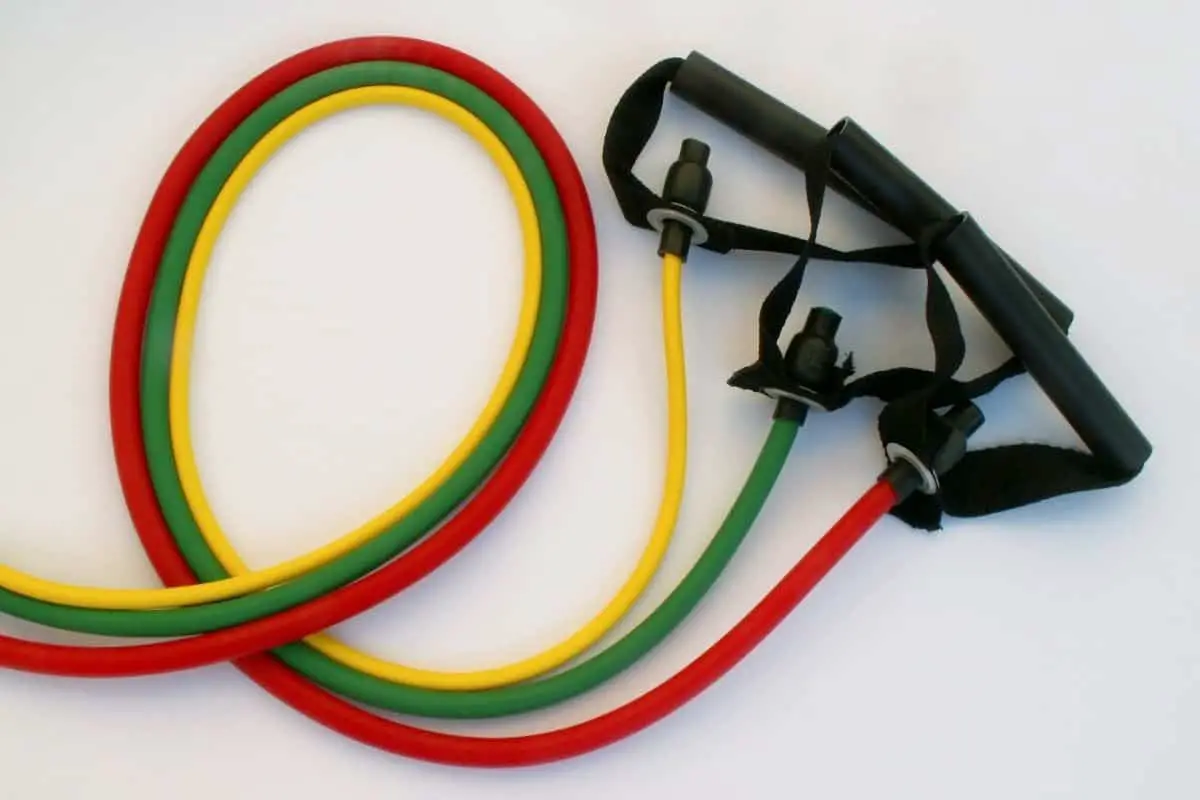There are two main types of resistance bands. Loop band and tube bands with handles. What are the differences and which one is better? I’ve done some research and here are the results.
A set of tube resistance bands with handles is a better choice if you are looking for a stand-alone workout solution. Loop bands have more uses and are better for incorporation into a weightlifting routine but aren’t as comfortable to use.
To discover the exact differences and which one is best for your situation, keep reading below.
Contents
What’s the difference between loop bands and tube bands?
What are the differences between resistance bands with handles and loop bands? Let’s take a look at what they actually look like. That will already give you a few hints on what the differences are.
Loop resistance band: A continuous rubber band. The elastic band itself is rectangular and has edges. This is basically a big rubber band. There is no end to this band because it’s

Tube resistance bands with handles: A tubular resistance band that’s hollow inside. At both ends there is a handle or an eyelet where you can attach different attachments.

Both types are resistance bands and they’re used for very similar purposes. Instead of listing all the similarities, it’s more useful to look at the differences;
Pros and cons of loop bands
First let’s take a closer look at loop bands. What are the pros and cons of this type of band?
Pros
- Higher maximum resistance for a single: Loop bands come in higher resistances. The heaviest loop band is quite a bit heavier than the heaviest tube band. Tube bands can often be stacked though.
- Bigger resistance range: While the heaviest loop bands are heavier, the lighter ones are the same weight so the range of resistances is wider.
- More exercise options: Loop bands provide more exercise options in total. Loop bands can be used for standalone exercises but also be incorporated into other exercises to change the power curve.
- Easy to integrate into weight training: Combine loop resistance bands with squats and bench presses for extra gains. You can use these bands at home but also take them to the gym for extra uses.
- Smaller to store: The bands themselves are actually a little bigger than tube bands but, they don’t have handles. That means they’re easier to put away in a very tiny space although both types don’t require a lot of space.
Cons
- No easy grip handles: Loop bands don’t come with handles or a way to attach anything. You’ll have to grip the band itself which can be a little bit uncomfortable.
- Part of the loop between your hands can get in the way: Since it’s a loop, you’ll have a bit of band left over between your hands. This can get in the way although you can work around it.
By the way: There are a few more different types of resistance bands. Find more about them here.
Pros and cons of tube bands
Pros
- Tube bands tend to last longer than loop bands. Some tube bands also have a ‘snap guard’. This is a kind of wire inside the tube that prevents from overstretching it and snapping it. This increases safety.
- Tube bands can be stacked easily by attaching them to the same attachment.
- This type of bands often comes in sets. These sets have different resistance tubes, different attachments, different
- They have handles: The biggest difference between loop bands and tube bands is that tube bands have handles. Instead of a loop, you have a length of resistance band with handles on both sides. This makes it easier to grab and hold on to.
- More comfortable: The handles mean it’s more comfortable to hold onto.
Cons
- Tube bands can be a bit uncomfortable when pressed to the body since the surface is a lot smaller. That means you have more pressure on a smaller spot. During some exercises the bands will touch the body and press on it. In most cases this is a pretty small drawback and a long sleeve t-shirt will fix most of this.
- If tube bands break (which is uncommon but can happen in rare instances), it can possibly cause more damage than loop bands. What sometimes happens is that the little eyelet let’s go. So when you attach the band to an anchor and it snaps, a part of the tube can catapult into your body. Again, this is quite rare although it has happened to me.
- Tube bands are harder to integrate into weight training: Tube bands are just for using standalone. They aren’t easily integrated into other workouts like weight training.
Tube bands vs. loop resistance bands for a home gym
You can find the pros and cons of both types above. But which type is better to get for your home gym?
Frankly, if you’ve got the money, you can get a set of both because they don’t cost too much and have their own uses. However, nobody likes to waste money so if you’ve got the money to buy only one set of one type, which should it be?
If you want to get a set of resistance that is stand-alone and can provide a full workout and is comfortable to use, get a set of tube resistance bands with handles. They are a more complete standalone solution and more comfortable than loop bands.
However, if you want to use your resistance bands to be incorporated into weightlifting while also using them for other accessory and corrective exercises, loop bands are better for you.
Either way, you’ll need a way to anchor your bands somehow. Read up here on how to do this safely and cheaply.

Differences between tube and loop resistance bands
If you’re still not sure what’s best for you, let’s go even deeper into the differences. There are a few factors that come into play when comparing the two;
- Exercise differences
- Comfort
- Resistance
- Storage
- Price
- Quality
- Safety
Exercise differences
What are the practical differences between tube bands and loop bands if we look at exercising? Most exercises can be done with both types of band.
Loop bands are generally easier to integrate into weight training. Like adding them onto a barbell exercise or pull up. Those exercises where you want the wider resistance range a loop bands provides. More on that later.
Other benefits of loop bands are that they are better suited for mobility work, flexibility, yoga and Pilatus.
Loop bands are….. a loop. That means the part between your hands can sometimes get in the way a little. Tube bands stop at the handle which means they are open otherwise.
In practice that means that tube bands replicate dumbbell a bit closer. That makes tube bands better for pressing and pushing exercises but for most other exercises, loop bands can offer you more.

Comfort
There is actually a difference in comfort when using different resistance bands. However, it’s not that one type is more comfortable than the other. It depends on the specific situation which one provides the better comfort.
Loop bands are wider while tube bands are quite narrow. That means if you hold the band under your feet, the loop bands distribute the weight over a bigger area so there is less pressure in one spot. This also goes for rotational exercises or other movements where the band touches your body.
For your hands it’s the other way around. Because the tube bands will have handles, it’s a bit nicer on your hands. If you’re anchoring your resistance bands to the wall or door for most exercises, tube bands with handles are better.
The handles are made to be comfortable and easy to hold so if you don’t have to worry about the other side because it’s anchored, tube bands are better.
Resistance
We have to look at two factors of resistance;
- Maximum
- Range
The maximum resistance is obviously the highest resistance a band can provide.
Loop bands maximum resistances range from 15 to 200 lbs.
Tube bands come with max resistances of 10 to 50 lbs. tubes can be stacked quite easily however. Just attach a 40 and 50 lbs. band to the same handles and you’ve got 90 lbs. Most sets can be stacked up to 150lbs. although a single loop band is more convenient than stacking 5 tubes.
The range is where the resistance starts and ends. Of course it ends at the maximum resistance but not every band has as much variability
In general, loop bands have a wider range of resistance while the tube bands have a much narrower one. For example, a loop band can have a range of 35-65 lbs. while a tube band has a range of 55-65 lbs.
Both ranges have their pros and cons. Loop bands are a bit more flexible in training and have a higher maximum resistance for extra muscle and strength gains.
Tube bands provide more consistent resistance although lower in total.
Suggested: Can resistance bands break?
Storage
Which type is easier to store? Storage might not sound very important since resistance bands are small anyways. If you want to travel or put them in a very tight space, it becomes more important.
Both types should be stored somewhere outside of direct sunlight since UV light will degrade resistance bands much faster than they should.
Size wise, both types don’t take up much space but loop bands are actually a bit smaller. That’s because you don’t need any attachments for the loop bands. While tube bands by themselves are a bit smaller, the attachments you need to use them means the whole set takes up more space.

Price
There is more than one brand that sells resistance bands of either type. They sell their products at different prices for all kinds of reasons. The prices are close enough that there is a big overlap in prices.
One thing to keep in mind is that tubular bands with handles are usually sold as a complete combo with tubes, attachments, anchors, etc. That makes price comparison difficult. In a combo you usually get a better deal than if you would buy separate items.
That said, if you buy five loop bands, you’ll pay about the same as a set of five tube bands with handles of similar quality.
Quality
Of course within both types there are a range of qualities, materials and prices. For both types goes that higher quality bands will last longer. While construction and material use are different between the types, the longevity is similar. For average quality bands, tubes stay good for a bit longer.
Safety
That brings us to the safety. Even good quality bands have their limits and will degrade over time. The higher the quality, the further away the limits will be. Both types are safe to exercise with. Resistance bands are easy on the joints and it’s very unlikely you’ll injure yourself while using them.
One thing that can hurt you is when a band breaks. Especially under load, a breaking band can do a lot of damage it if hits the wrong body part or even something like a window.
High quality loop bands are layered. That means they’re built up from more than one sheet of latex. this means there is a very low change the band will snap in a single instance.
Tube bands are made of a single thicker layer. That means if it fails, it completely fails.
On the other hand, some tube bands have ‘snap guards’ inside the tube that prevent you from overstretching them.
Tube bands have eyelets attached to them. From personal experience those eyelets can let go. It might not be common but it can happen. In my case the eyelet that was anchored to the wall let go and the band hit me in the back of the head. Luckily I was facing away at the time. It wasn’t a cheap brand either but I’m not going to name names.
For that reason alone, my personal preference lies with loop bands. Loop bands won’t snap in a single moment but unravel slower.

